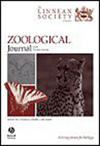Mediterranean conquerors: neotypification and phylogeography of the widely distributed earthworms Aporrectodea trapezoides and Octodrilus complanatus (Lumbricidae: Crassiclitellata)
IF 2.8
2区 生物学
Q1 ZOOLOGY
引用次数: 0
Abstract
Cryptic lineages require identification and delimitation to guide their conservation and management. In the absence of type material that can be genotyped, designating a neotype becomes necessary: such is the case for Aporrectodea trapezoides and Octodrilus complanatus. These widely distributed earthworms are very common in Mediterranean habitats and harbour cryptic lineages. Specimens from the type locality (Jardin des Plantes, Montpellier) were genotyped to be included in species delimitation, phylogeographical, and phylogenetic analyses together with additional sequences from Mediterranean populations and close relatives. The Octodrilus complanatus neotype belonged to a clade inhabiting Spain, France, and Italy, with a putative origin in central Italy; two other species-level clades were restricted to northeastern Italy, Slovenia, and Croatia. The Aporrectodea trapezoides neotype clustered with a peregrine, Iberian, and Maghrebian specimens, together forming Aporrectodea trapezoides s.s. More restricted and accurate descriptions based on the neotypes and closely related specimens pointed out to the Eurosiberian lineage of Aporrectodea trapezoides s.l. corresponding to Aporrectodea borelii and provided a basis for the potential description of Octodrilus complanatus s.l. lineages. On top of the taxonomic advances, this work detected differences in their phylogeographical patterns (potentially connected to historical human dispersal) and provided an opportunity for more accurate ecological niche modelling.地中海征服者:广泛分布的梯形无角蚓和面八尾蚓的新类型和系统地理学(蚓科:长尾蚓目)
隐种谱系需要鉴定和划分,以指导其保护和管理。在没有可以进行基因分型的类型材料的情况下,指定一个新类型就变得必要了:例如梯形无角鲸和面八角鲸。这些广泛分布的蚯蚓在地中海栖息地非常常见,并拥有隐藏的血统。来自模式地点(Jardin des Plantes, Montpellier)的标本进行基因分型,并与来自地中海种群及其近亲的额外序列一起用于物种划分、系统地理和系统发育分析。新型平八爪龙属于生活在西班牙、法国和意大利的一个分支,据推测起源于意大利中部;另外两个物种级别的分支仅限于意大利东北部、斯洛文尼亚和克罗地亚。该新型与一个远游、伊比利亚和马格里布标本聚集在一起,形成了一个更有限制和准确的描述。基于新型和密切相关的标本,指出了与北方准直齿兽相对应的欧洲西伯利亚准直齿兽谱系,并为拟平八角龙谱系的潜在描述提供了基础。在分类学的进步之上,这项工作发现了它们的系统地理模式的差异(可能与历史上的人类分散有关),并为更准确的生态位建模提供了机会。
本文章由计算机程序翻译,如有差异,请以英文原文为准。
求助全文
约1分钟内获得全文
求助全文
来源期刊
CiteScore
6.50
自引率
10.70%
发文量
116
审稿时长
6-12 weeks
期刊介绍:
The Zoological Journal of the Linnean Society publishes papers on systematic and evolutionary zoology and comparative, functional and other studies where relevant to these areas. Studies of extinct as well as living animals are included. Reviews are also published; these may be invited by the Editorial Board, but uninvited reviews may also be considered. The Zoological Journal also has a wide circulation amongst zoologists and although narrowly specialized papers are not excluded, potential authors should bear that readership in mind.

 求助内容:
求助内容: 应助结果提醒方式:
应助结果提醒方式:


